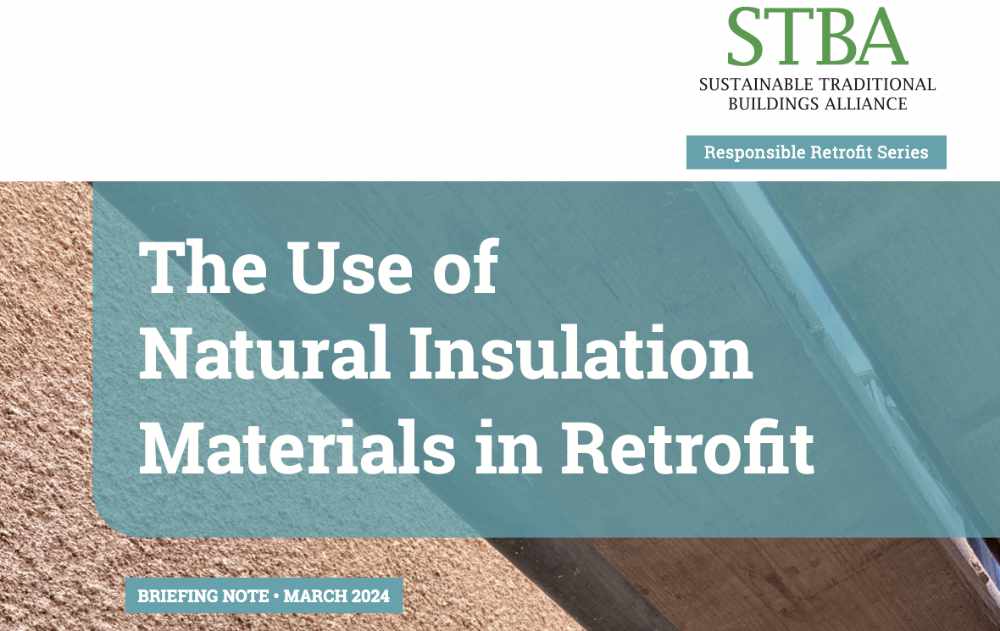Natural materials for retrofits
Contents |
[edit] Championing natural materials to de-risk retrofit
In a new paper, the Sustainable Traditional Buildings Alliance (STBA), which is hosted by the Sustainable Development Foundation (SDF), has identified a number of barriers to best practice retrofit of traditional solid wall buildings, and calls for steps to be taken to remove these barriers, facilitate sustainable retrofit, and ensure the use and enjoyment of our heritage buildings for years to come.
25% of the UK’s building stock is of traditional construction, meaning they are solid-walled and rely on a vapour-open strategy to manage moisture. For these buildings, the unconsidered use of modern impermeable materials can introduce a risk of moisture accumulation and resultant damp and mould.
The paper, The Use of Natural Insulation Materials in Retrofit, explores the energy and carbon characteristics of natural materials, their moisture handling characteristics, and the regulatory context.
On the basis of its analysis, it calls for five actions from government that will help enable best practice retrofit of traditional buildings. The recommendations are to:
- Eliminate the requirement for a 25-year guarantee on solid wall insulation from current Trustmark lodgment rules. Consider introducing a requirement for a 10-year guarantee, or use public funds to expedite longer-term guarantees for natural materials.
- Work with the insurance industry to help them understand the ways in which natural materials can help de-risk retrofit.
- Ensure that the Government’s own guidance on internal wall insulation across all typologies is well understood by all relevant policy officers.
- Establish a broad range of metrics for retrofit materials, to encompass: resource scarcity, sequestered carbon, embodied energy, water use and embodied pollution. EPDs (Environmental Performance Declarations) or Materials Passports could be considered as a starting point.
- Establish a broad range of metrics for retrofit, including benefits to health, welfare, net energy savings, water efficiency and sustainable drainage, and include wider community benefits such as employment, green spaces, and social cohesion.
This article appears on the SDF website as 'Championing natural materials to de-risk retrofit' from April 2024.
[edit] About SDF
The Sustainable Development Foundation aims to drive the property and construction industry towards exemplary sustainability practices. In order to achieve this, the SDF has two main roles: as a Think Tank and as part of an Alliance.
For further information visit: https://sdfoundation.org.uk/
[edit] About STBA
The Sustainable Traditional Buildings Alliance is a collaboration of organisations that acts as a forum for sustaining and improving solid-wall buildings.
The STBA develops policy, guidance and training to minimise risks and maximise benefits to traditional buildings and their owners with a focus on five key areas; the health of the occupants, the health and durability of the building fabric, the energy consumption attributed to the building/occupant, the impact on our communities and culture and the impact on the natural environment
For further information visit: https://stbauk.org/
[edit] Related articles on Designing Buildings
- Definitions of retrofitting.
- Energy efficiency of traditional buildings.
- Energy efficiency retrofit training videos.
- Energy Performance Certificates.
- Fabric first.
- Government urged to include home energy retrofits in Industrial Strategy.
- Home Energy Masterplan.
- Households Declare.
- How to deal with retrofit risks.
- National Retrofit Strategy NRS.
- New energy retrofit concept: 'renovation trains' for mass housing.
- PAS 2035.
- PAS 2038:2021 Retrofitting non-domestic buildings for improved energy efficiency.
- Refurbishment.
- Renovation.
- Renovation v refurbishment v retrofit.
- Retrofit and traditional approaches to comfort.
- Retrofit coordinator.
- Retrofit, refurbishment and the growth of connected HVAC technology.
- Retrofitting solar shading.
- Shallow retrofit.
- Step-by-step retrofit.
Featured articles and news
Latest Build UK Building Safety Regime explainer published
Key elements in one short, now updated document.
UKGBC launch the UK Climate Resilience Roadmap
First guidance of its kind on direct climate impacts for the built environment and how it can adapt.
CLC Health, Safety and Wellbeing Strategy 2025
Launched by the Minister for Industry to look at fatalities on site, improving mental health and other issues.
One of the most impressive Victorian architects. Book review.
Common Assessment Standard now with building safety
New CAS update now includes mandatory building safety questions.
RTPI leader to become new CIOB Chief Executive Officer
Dr Victoria Hills MRTPI, FICE to take over after Caroline Gumble’s departure.
Social and affordable housing, a long term plan for delivery
The “Delivering a Decade of Renewal for Social and Affordable Housing” strategy sets out future path.
A change to adoptive architecture
Effects of global weather warming on architectural detailing, material choice and human interaction.
The proposed publicly owned and backed subsidiary of Homes England, to facilitate new homes.
How big is the problem and what can we do to mitigate the effects?
Overheating guidance and tools for building designers
A number of cool guides to help with the heat.
The UK's Modern Industrial Strategy: A 10 year plan
Previous consultation criticism, current key elements and general support with some persisting reservations.
Building Safety Regulator reforms
New roles, new staff and a new fast track service pave the way for a single construction regulator.
Architectural Technologist CPDs and Communications
CIAT CPD… and how you can do it!
Cooling centres and cool spaces
Managing extreme heat in cities by directing the public to places for heat stress relief and water sources.
Winter gardens: A brief history and warm variations
Extending the season with glass in different forms and terms.
Restoring Great Yarmouth's Winter Gardens
Transforming one of the least sustainable constructions imaginable.























